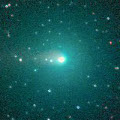
|
Now it is so bright as 7.0 mag (June 9, Michael Mattiazzo). It had been brightening very rapidly, but the brightness evolution slow down recently. It will approach to the sun down to 0.66 a.u. in July, and brighten up to 6 mag. It is already not observable in the Northern Hemisphere. It will be unobservable in early June also in the Southern Hemisphere. After the perihelion passage, it will be observable in excellent condition after late July in the Northern Hemisphere. In the Southern Hemisphere, it keeps unobservable until early September.
Date(TT) R.A. (2000) Decl. Delta r Elong. m1 Best Time(A, h)
June 7 6 30.75 12 5.1 1.663 0.847 24 7.1 18:25 (109, 5)
June 14 6 21.74 14 23.5 1.698 0.768 15 6.7 18:25 (106, -3)
|

|
Now it is bright as 8.0 mag (June 6, Maik Meyer). The brightening is somewhat slow, but it is expected to brighten up to 6-7 mag in 2014 autumn. It keeps observable in good condition for a long time in the Northern Hemisphere. It keeps locating low in the Southern Hemisphere.
Date(TT) R.A. (2000) Decl. Delta r Elong. m1 Best Time(A, h)
June 7 10 28.89 39 38.3 1.721 1.675 70 8.6 18:25 (168, 14)
June 14 10 12.60 36 32.0 1.803 1.596 61 8.5 18:25 (159, 15)
|
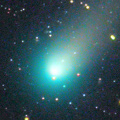
|
It brightened rapidly in outburst in mid October. Now it is bright as 8.7 mag (June 7, Marco Goiato). It keeps 8-9 mag until July. In the Northern Hemishpere, it keeps observable in the morning sky until July. In the Southern Hemisphere, it keeps observable in good condition for a long time until the comet fades out.
Date(TT) R.A. (2000) Decl. Delta r Elong. m1 Best Time(A, h)
June 7 22 20.85 -21 50.8 1.590 2.117 106 8.9 5:20 (180, 77)
June 14 22 26.27 -24 36.5 1.570 2.175 112 9.0 4:58 (180, 79)
|
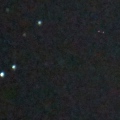
|
Cometary activity began. Now it is bright as 11.9 mag (June 6, Alan Hale). It will brighten up to 7 mag in July, and will be observable in excellent condition in the Northern Hemisphere. In the Southern Hemisphere, it is not observable temporarily in mid July, but it is observable before and after mid July.
Date(TT) R.A. (2000) Decl. Delta r Elong. m1 Best Time(A, h)
June 7 1 4.62 0 56.9 1.271 1.179 60 11.3 5:32 (233, 39)
June 14 0 59.51 4 24.5 1.040 1.139 67 10.6 5:35 (221, 42)
|
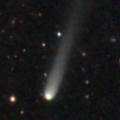
|
Now it is 14.3 mag (Mar. 30, Taras Prystavski). It is expected to brighten up to 7.5 mag and to be observable in excellent condition from summer to autumn in 2014 in the Southern Hemisphere. It keeps observable for a long time in the Southern Hemisphere, although it becomes low temporarily in May. It keeps unobservable for a while in the Northern Hemisphere. It will pass extremely close to Mars in 2014 October.
Date(TT) R.A. (2000) Decl. Delta r Elong. m1 Best Time(A, h)
June 7 3 8.55 -23 43.1 2.836 2.379 53 11.7 5:32 (279, 30)
June 14 3 12.01 -24 16.1 2.682 2.308 57 11.5 5:35 (277, 36)
|
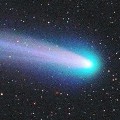
|
It passed only 0.4 A.U. from the earth, and 0.8 A.U. from the sun in November and December, and brightened up to 4.7 mag (Nov. 28, Juan Jose Gonzalez). Now it is 11.8 mag (May 31, Carlos Labordena). It keeps observable until 2014 autumn when the comet fades out.
Date(TT) R.A. (2000) Decl. Delta r Elong. m1 Best Time(A, h)
June 7 16 25.83 -23 31.6 1.731 2.740 172 11.9 23:21 (180, 79)
June 14 16 12.87 -24 33.3 1.840 2.826 162 12.1 22:41 (180, 80)
|
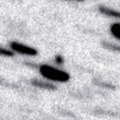
|
The condition in this apparition is bad. It locates low around the brightest days. Now it is not observable. It will appear in the morning sky at 13 mag in late July.
Date(TT) R.A. (2000) Decl. Delta r Elong. m1 Best Time(A, h)
June 7 3 50.30 17 10.0 2.600 1.657 17 12.2 5:32 (250, -1)
June 14 4 11.14 17 47.9 2.591 1.662 18 12.2 5:35 (248, 0)
|
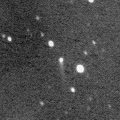
|
It approached to the earth down to 0.06 a.u. in late May, and looked very bright as 11.8 mag (May 29, Marco Goiato). It will be fading very rapidly after this. In the Southern Hemisphere, it keeps observable for a long time until the comet fades out. It will never be observable again in the Northern Hemisphere.
Date(TT) R.A. (2000) Decl. Delta r Elong. m1 Best Time(A, h)
June 7 12 18.98 -61 54.7 0.101 1.068 119 13.1 19:22 ( 0, 62)
June 14 13 49.77 -72 32.5 0.163 1.112 122 14.2 20:26 ( 0, 52)
|

|
New outburst occured on May 2, and it brightened up to 13.0 mag (May 3, Seiichi Yoshida). Another outburst occured on May 12, and it brightened up to 12.7 mag (May 12, Con Stoitsis). Now it looks diffuse, but still bright as 12.4 mag (May 27, Marco Goiato).
Date(TT) R.A. (2000) Decl. Delta r Elong. m1 Best Time(A, h)
June 7 15 29.36 -29 51.9 5.180 6.136 158 13.5 22:26 (180, 85)
June 14 15 26.44 -29 35.3 5.219 6.135 152 13.5 21:56 (180, 85)
|
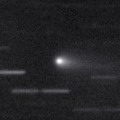
|
Now it is 14.2 mag (May 27, Taras Prystavski). It keeps bright as 13-14 mag for a long time from 2013 to 2014.
Date(TT) R.A. (2000) Decl. Delta r Elong. m1 Best Time(A, h)
June 7 21 9.75 -26 11.3 2.399 3.077 123 13.7 4:10 (180, 81)
June 14 21 10.52 -26 36.3 2.330 3.081 129 13.6 3:43 (180, 82)
|
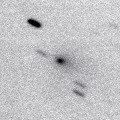
|
It brightened up to 2 mag by unusual major outburst in 2007. It is coming back now. Now it is bright as 13.1 mag (June 7, Alan Hale). In the Northern Hemisphere, it keeps observable until it fades out in 2015. In the Southern Hemisphere, it keeps extremely low after this.
Date(TT) R.A. (2000) Decl. Delta r Elong. m1 Best Time(A, h)
June 7 1 58.50 24 17.7 2.786 2.131 41 13.7 5:32 (227, 13)
June 14 2 12.64 26 8.2 2.753 2.146 44 13.8 5:35 (223, 14)
|
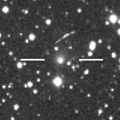
|
Brightened rapidly. Now it is 14.5 mag (May 21, Taras Prystavski). It will brighten up to 13-14 mag and will be observable in excellent condition from spring to summer in the Southern Hemisphere. It locates somewhat low in the Northern Hemispehre.
Date(TT) R.A. (2000) Decl. Delta r Elong. m1 Best Time(A, h)
June 7 9 59.06 -15 18.8 1.767 1.921 82 13.9 18:25 (130, 62)
June 14 10 17.10 -15 3.2 1.808 1.919 80 13.9 18:25 (126, 61)
|
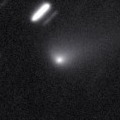
|
Now it is bright as 12.0 mag (May 30, Uwe Pilz). It keeps observable at 13 mag in excellent condition from spring to summer.
Date(TT) R.A. (2000) Decl. Delta r Elong. m1 Best Time(A, h)
June 7 13 50.64 -8 41.4 1.776 2.575 132 14.0 20:48 (180, 64)
June 14 13 52.55 -8 44.6 1.842 2.579 126 14.1 20:22 (180, 64)
|
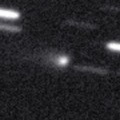
|
Now it is 14.9 mag (Apr. 18, Taras Prystavski). It is expected to brighten up to 5 mag in 2014 autumn. Now it is not observable. It will be observable again in July in the Southern Hemisphere, or in August in the Northern Hemisphere.
Date(TT) R.A. (2000) Decl. Delta r Elong. m1 Best Time(A, h)
June 7 5 13.21 17 15.5 3.128 2.123 6 14.2 18:25 (102,-13)
June 14 5 17.92 16 57.3 3.029 2.024 6 14.0 5:35 (258,-13)
|

|
Now it is 13.1 mag (May 23, Taras Prystavski). It keeps bright at 13-14 mag for a long time until 2014.
Date(TT) R.A. (2000) Decl. Delta r Elong. m1 Best Time(A, h)
June 7 19 33.06 2 53.3 5.732 6.485 134 14.0 2:33 (180, 52)
June 14 19 27.70 2 26.8 5.682 6.505 141 14.0 2:00 (180, 53)
|
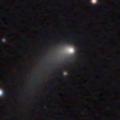
|
Now it is 14.2 mag (May 22, Taras Prystavski). It keeps 14 mag for a long time until 2014 summer. It keeps observable in good condition in the Northern Hemisphere. It keeps unobservable after this in the Southern Hemisphere.
Date(TT) R.A. (2000) Decl. Delta r Elong. m1 Best Time(A, h)
June 7 7 27.27 66 52.9 2.248 1.773 49 14.2 18:25 (159,-21)
June 14 8 18.32 67 3.0 2.262 1.807 51 14.3 18:25 (161,-20)
|

|
It brightened up to 11-12 mag in 2012. Now it is 14.2 mag (May 21, Taras Prystavski). It will be observable in good condition at 14 mag until 2014 early summer.
Date(TT) R.A. (2000) Decl. Delta r Elong. m1 Best Time(A, h)
June 7 11 53.58 -7 16.7 7.342 7.672 105 14.3 18:51 (180, 62)
June 14 11 51.67 -7 1.6 7.498 7.708 98 14.4 18:25 (178, 62)
|
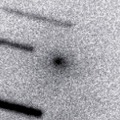
|
Now it is very bright as 13.1 mag (June 4, Taras Prystavski). It brightened up to 9 mag at the discovery in 2005. It approaches to the sun down to 0.8 a.u. on May 29. However, it will brighten up to 13-14 mag at best. In this apparition, it keeps observable in the morning sky all through the period. But it locates extremely low around the perihelion passage in the Northern Hemisphere.
Date(TT) R.A. (2000) Decl. Delta r Elong. m1 Best Time(A, h)
June 7 2 1.25 8 40.5 1.151 0.836 44 14.5 5:32 (239, 24)
June 14 2 30.74 10 56.6 1.223 0.859 43 14.9 5:35 (237, 23)
|
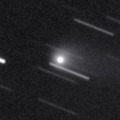
|
Now it is bright as 13.6 mag (June 4, Taras Prystavski). It keeps 13-14 mag and observable in good condition in the Northern Hemisphere for a long time from 2013 to 2014. In the Southern Hemisphere, it is not observable until 2014 autumn.
Date(TT) R.A. (2000) Decl. Delta r Elong. m1 Best Time(A, h)
June 7 1 20.66 52 9.3 4.317 3.758 50 14.7 5:32 (204, -5)
June 14 1 21.48 52 22.7 4.280 3.784 54 14.7 5:35 (200, -3)
|
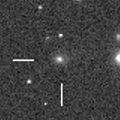
|
Now it is 14.8 mag (May 22, Taras Prystavski). It is expected to brighten up to 13 mag and to be observable in good condition in 2015. In 2014, it keeps observable in good condition from winter to summer.
Date(TT) R.A. (2000) Decl. Delta r Elong. m1 Best Time(A, h)
June 7 13 35.01 0 49.7 3.754 4.415 125 14.8 20:32 (180, 54)
June 14 13 34.82 0 46.3 3.801 4.378 118 14.8 20:04 (180, 54)
|
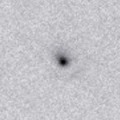
|
Now it is not observable. In the Northern Hemisphere, it will appear in the morning sky in late July. Then it will be observable at 12-13 mag in excellent condition from 2014 summer to 2015 spring. In the Southern Hemisphere, it will locate low around the highlight.
Date(TT) R.A. (2000) Decl. Delta r Elong. m1 Best Time(A, h)
June 7 4 9.03 21 9.4 3.304 2.320 11 15.0 5:32 (249, -7)
June 14 4 24.27 22 3.8 3.258 2.291 14 14.9 5:35 (247, -5)
|
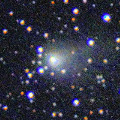
|
First return of a new periodic comet discovered in 1998. It brightened up to 10 mag at the discovery, but it brightened up to 11-12 mag at best in this apparition. Now it is 13.8 mag (May 21, Taras Prystavski). It will be fading after this. It will be unobservable in mid June. In the Southern Hemisphere, it keeps observable until August.
Date(TT) R.A. (2000) Decl. Delta r Elong. m1 Best Time(A, h)
June 7 8 53.61 8 7.7 2.674 2.303 57 14.9 18:25 (132, 34)
June 14 9 6.25 6 48.9 2.759 2.326 54 15.0 18:25 (128, 33)
|

|
Big asteroid discovered in 1906. It suddenly showed the cometary activity on Dec. 11, 2010, probably due to an impact of a small object. It has already turned to be stellar.
Date(TT) R.A. (2000) Decl. Delta r Elong. m1 Best Time(A, h)
June 7 3 19.08 12 41.4 4.237 3.353 25 15.2 5:32 (249, 7)
June 14 3 27.75 13 22.2 4.197 3.357 30 15.2 5:35 (245, 11)
|
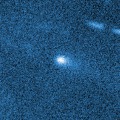
|
Now it is 15.8 mag (May 6, A. Maury, J.-G. Bosch, J.-F. Soulier, T. Noel). It keeps 15-16 mag until August. But it keeps low for a while.
Date(TT) R.A. (2000) Decl. Delta r Elong. m1 Best Time(A, h)
June 7 2 38.77 13 34.7 2.186 1.466 34 15.4 5:32 (242, 14)
June 14 3 0.91 15 1.1 2.169 1.468 35 15.4 5:35 (239, 15)
|

|
Now it is 16.4 mag (June 9, A. Maury, J.-G. Bosch, J.-F. Soulier, T. Noel). In the Southern Hemisphere, it has already appeared in the morning sky. In the Northern Hemisphere, it is not observable until early July. But it will be observable in good condition after that while the comet will be fading gradually. In the Southern Hemisphere, it keeps extremely low.
Date(TT) R.A. (2000) Decl. Delta r Elong. m1 Best Time(A, h)
June 7 2 46.73 8 41.1 2.339 1.612 34 15.8 5:32 (247, 16)
June 14 3 5.63 10 57.8 2.297 1.593 36 15.6 5:35 (243, 17)
|
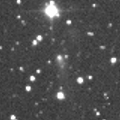
|
Now it is 14.9 mag (May 21, Taras Prystavski), brighter than origianlly predicted. It will be observable at 14-16 mag for a long time from 2013 to 2014.
Date(TT) R.A. (2000) Decl. Delta r Elong. m1 Best Time(A, h)
June 7 15 52.73 -25 8.4 3.223 4.211 164 15.8 22:49 (180, 80)
June 14 15 49.15 -25 2.9 3.271 4.226 157 15.9 22:18 (180, 80)
|
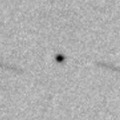
|
Now it is 15.9 mag (June 2, Taras Prystavski). Getting brighter than originally expected. It is expected to brighten up to 4 mag from autumn to winter in 2015. It already locates high in the Southern Hemisphere. It will be getting higher gradually also in the Northern Hemisphere. It is observable in good condition in the Southern Hemisphere until the highlight, or in the Northern Hemisphere after the highlight.
Date(TT) R.A. (2000) Decl. Delta r Elong. m1 Best Time(A, h)
June 7 0 3.06 -11 47.2 6.551 6.457 80 16.2 5:32 (227, 59)
June 14 0 3.70 -12 3.5 6.371 6.394 86 16.1 5:35 (215, 63)
|

|
Not been observed yet in this apparition. But it should be already bright as 16.5 mag. It is observable in morning low sky in the Southern Hemisphere. It will brighten up to 16 mag from May to June. In the Northern Hemisphere, it will become observable in July, when the comet will be fainter than 18 mag already.
Date(TT) R.A. (2000) Decl. Delta r Elong. m1 Best Time(A, h)
June 7 2 39.82 10 1.6 1.782 1.125 35 16.3 5:32 (245, 16)
June 14 3 5.47 13 16.1 1.790 1.125 35 16.3 5:35 (241, 15)
|

|
Now it is 20.4 mag (May 31, E. Jehin, C. Opitom, J. Manfroid, M. Gillon). Much fainter than predicted. It will brighten very rapidly after this, and it is expected to reach up to 10 mag in August. It keeps observable in the morning sky until mid August while the comet will be brightening. The condition is good in the Southern Hemisphere. But it keeps extremely low in the Northern Hemisphere.
Date(TT) R.A. (2000) Decl. Delta r Elong. m1 Best Time(A, h)
June 7 0 49.61 -3 22.1 1.452 1.395 66 17.0 5:32 (233, 45)
June 14 1 17.60 -0 56.2 1.337 1.300 65 16.3 5:35 (230, 44)
|
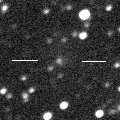
|
Now it is 16.5 mag (May 21, Taras Prystavski). Distant object, but it keeps observable at 14 mag for a long time from 2015 to 2016.
Date(TT) R.A. (2000) Decl. Delta r Elong. m1 Best Time(A, h)
June 7 19 17.29 -1 59.3 6.188 7.002 140 16.4 2:17 (180, 57)
June 14 19 15.47 -1 54.8 6.101 6.969 146 16.4 1:48 (180, 57)
|
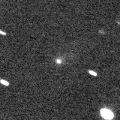
|
It brightened rapidly, and reached up to 15.7 mag (Apr. 22, Taras Prystavski). It will start fading after June, and will be fainter than 18 mag in August.
Date(TT) R.A. (2000) Decl. Delta r Elong. m1 Best Time(A, h)
June 7 13 46.98 -16 42.9 1.307 2.145 134 16.6 20:44 (180, 72)
June 14 13 47.27 -17 41.5 1.366 2.148 128 16.7 20:17 (180, 73)
|

|
Now it is 16.5 mag (Apr. 16, Taras Prystavski). It keeps 17 mag for a long time from 2014 to 2015. It is observable in excellent condition in the Northern Hemisphere. It is observable only until 2014 summer in the Southern Hemisphere.
Date(TT) R.A. (2000) Decl. Delta r Elong. m1 Best Time(A, h)
June 7 15 49.40 33 57.6 3.485 4.101 120 16.8 22:46 (180, 21)
June 14 15 45.46 34 36.8 3.514 4.080 117 16.8 22:14 (180, 20)
|
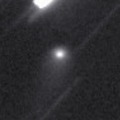
|
It brightened up to 14.0 mag from spring to summer in 2013 (June 11, Sandor Szabo). Now it is 15.7 mag, much brighter than origianlly predicted (Apr. 24, Taras Prystavski). In the Northern Hemisphere, it will be observable at 15-16 mag in excellent condition until spring. It locates somewhat low in the Southern Hemisphere.
Date(TT) R.A. (2000) Decl. Delta r Elong. m1 Best Time(A, h)
June 7 11 27.99 36 27.1 4.845 4.813 82 17.0 18:25 (180, 19)
June 14 11 26.14 36 17.6 4.998 4.856 76 17.2 18:25 (174, 18)
|
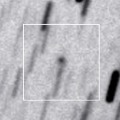
|
Now it is 17.5 mag (Apr. 5, N. James). It keeps observable at 18 mag for a long time from 2013 to 2016. It keeps locating high in the Northern Hemisphere. It keeps locating very low in the Southern Hemipshere.
Date(TT) R.A. (2000) Decl. Delta r Elong. m1 Best Time(A, h)
June 7 18 30.91 49 1.3 6.138 6.482 105 17.1 1:31 (180, 6)
June 14 18 21.92 49 47.6 6.125 6.479 106 17.1 0:55 (180, 5)
|
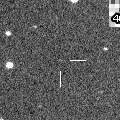
|
First return of a new periodic comet which brightened up to 13 mag in 2007. It was expected to brighten up to 13 mag again and observable in good condition from summer to autumn in 2014. But actually, it is 17.5 mag, much fainter than expected (Apr. 28, Taras Prystavski). It will be 16 mag at best actually.
Date(TT) R.A. (2000) Decl. Delta r Elong. m1 Best Time(A, h)
June 7 22 59.40 -5 2.6 2.106 2.368 91 17.2 5:32 (193, 59)
June 14 23 8.08 -4 39.1 2.015 2.356 96 17.1 5:35 (183, 60)
|
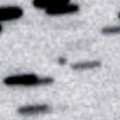
|
Now it is 16.4 mag (May 7, Taras Prystavski). It keeps 17-18 mag for a long time from 2014 to 2016.
Date(TT) R.A. (2000) Decl. Delta r Elong. m1 Best Time(A, h)
June 7 13 40.88 -10 53.6 4.863 5.585 131 17.1 20:37 (180, 66)
June 14 13 34.35 -10 44.9 4.951 5.570 123 17.1 20:04 (180, 66)
|
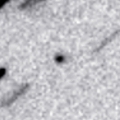
|
It was observed at 17.5 mag in early 2013. It will be observable at 17.5 mag again from spring to summer in 2014. But actually, no observations have been reported in 2014.
Date(TT) R.A. (2000) Decl. Delta r Elong. m1 Best Time(A, h)
June 7 19 42.89 -12 59.4 2.042 2.894 139 17.2 2:43 (180, 68)
June 14 19 40.44 -13 18.8 2.007 2.913 147 17.2 2:13 (180, 68)
|
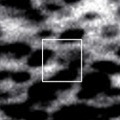
|
Now it is 18.2 mag (June 6, iTelescope Observatory, Mayhill). It will keep 16-17 mag for a long time from 2014 summer to early 2016.
Date(TT) R.A. (2000) Decl. Delta r Elong. m1 Best Time(A, h)
June 7 17 11.93 -27 15.8 1.938 2.950 174 17.5 0:13 (180, 82)
June 14 17 5.65 -26 58.0 1.909 2.921 173 17.4 23:34 (180, 82)
|
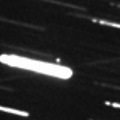
|
Now it is 18.2 mag (Apr. 22, D. Herald). It keeps 17-18 mag for a long time from 2013 to 2014. It is observable in excellent condition in the Southern Hemisphere. It is not observable in the Northern Hemisphere.
Date(TT) R.A. (2000) Decl. Delta r Elong. m1 Best Time(A, h)
June 7 10 54.78 -52 57.2 4.318 4.721 107 17.4 18:25 ( 15, 71)
June 14 10 49.76 -51 56.6 4.404 4.729 102 17.5 18:25 ( 30, 69)
|
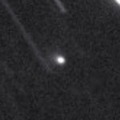
|
It approached to the earth down to 0.68 a.u. in spring, and brightened up to 15.6 mag (Mar. 29, Taras Prystavski). Now it is fading. It has already faded down to 17.2 mag (May 26, C. Bell). It will be fainter than 18 mag in June.
Date(TT) R.A. (2000) Decl. Delta r Elong. m1 Best Time(A, h)
June 7 10 59.92 -20 31.8 1.274 1.735 97 17.5 18:25 (156, 75)
June 14 11 9.40 -22 33.1 1.352 1.757 94 17.7 18:25 (138, 74)
|

|
Now it is 17.8 mag (Apr. 26, A. Maury, J.-F. Soulier). It has brightened in outburst up to 14 mag twice, in 2006 January and 2011 May. It will pass the perihelion in 2015. It keeps observable at 17 mag for a long time after this.
Date(TT) R.A. (2000) Decl. Delta r Elong. m1 Best Time(A, h)
June 7 21 19.54 -12 9.6 5.479 6.015 117 17.7 4:19 (180, 67)
June 14 21 19.46 -12 8.5 5.377 6.006 124 17.6 3:52 (180, 67)
|

|
First return of a new periodic comet discovered in 2005. It was expected to be observable at 17 mag for a long time from 2013 to 2014. However, it has not been recovered yet. Actually, it is much fainter than predicted, fainter than 20 mag (Aug. 6, Jean-Francois Soulier).
Date(TT) R.A. (2000) Decl. Delta r Elong. m1 Best Time(A, h)
June 7 22 57.42 -7 39.9 3.050 3.270 93 17.7 5:32 (193, 62)
June 14 23 1.55 -7 28.4 2.962 3.278 99 17.7 5:33 (180, 62)
|
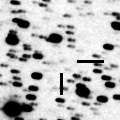
|
Now it is 18.4 mag (June 7, J. Nicolas, A. Klotz, F. Kugel, C. Rinner). It is observable at 18 mag in good condition from spring to summer.
Date(TT) R.A. (2000) Decl. Delta r Elong. m1 Best Time(A, h)
June 7 21 19.67 5 18.9 1.421 2.015 110 17.8 4:19 (180, 50)
June 14 21 20.48 7 47.5 1.388 2.040 115 17.8 3:53 (180, 47)
|
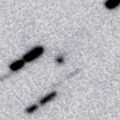
|
Now it is 18.3 mag (May 20, K. Hills). It keeps 17-18 mag for a long time until 2015.
Date(TT) R.A. (2000) Decl. Delta r Elong. m1 Best Time(A, h)
June 7 10 58.64 -5 28.1 3.213 3.403 91 17.9 18:25 (166, 60)
June 14 11 3.39 -5 36.1 3.296 3.390 86 17.9 18:25 (155, 58)
|
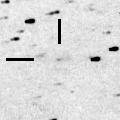
|
Now it is 17.1 mag (Apr. 14, A. Maury, J.-G. Bosch, T. Noel, J.-F. Soulier). It keeps 17-18 mag until June.
Date(TT) R.A. (2000) Decl. Delta r Elong. m1 Best Time(A, h)
June 7 18 32.38 -18 29.4 1.230 2.203 157 17.9 1:33 (180, 73)
June 14 18 25.86 -18 33.8 1.239 2.237 165 18.0 0:59 (180, 74)
|

|
It brightened up to 12-13 mag from 2012 to 2013. It has already gone away. But it is bright as 16.8 mag still now (May 29, K. Hills). It keeps 17-18 mag for a while, and it will be observable in good condition in the Southern Hemisphere. It will be getting higher gradually also in the Northern Hemisphere.
Date(TT) R.A. (2000) Decl. Delta r Elong. m1 Best Time(A, h)
June 7 0 36.71 -12 42.4 3.915 3.752 73 17.9 5:32 (239, 54)
June 14 0 42.08 -12 33.2 3.838 3.770 78 17.9 5:35 (231, 58)
|

|
Now it is 17.6 mag (May 10, Taras Prystavski). It keeps 18 mag for a long time from 2013 to 2014.
Date(TT) R.A. (2000) Decl. Delta r Elong. m1 Best Time(A, h)
June 7 15 38.19 19 44.1 6.815 7.546 133 17.9 22:34 (180, 35)
June 14 15 33.19 20 4.8 6.878 7.551 128 18.0 22:02 (180, 35)
|
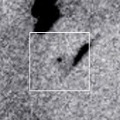
|
Now it is 19.4 mag (May 3, A. Waszczak). First return of a new periodic comet which brightened up to 13 mag in outburst in 2008. It will be observable in good condition from spring to summer. However, it will be only 19-20 mag at best in this apparition.
Date(TT) R.A. (2000) Decl. Delta r Elong. m1 Best Time(A, h)
June 7 12 17.96 11 21.2 1.961 2.405 103 19.7 19:16 (180, 44)
June 14 12 22.65 10 11.2 2.029 2.396 98 19.7 18:53 (180, 45)
|
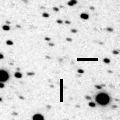
|
It was discovered in 1819, and re-discovered in 2003. Although it was predicted to be extremely faint as 26 mag, it unusually brightened up to 17.5 mag in outburst in 2013 July (July 6, Hidetaka Sato). However, no observations have been reported since mid July. It will pass the perihelion in 2014 August, and will approach to the sun down to 0.96 a.u. The brightness is predicted to be 23 mag at best. However, if the cometary activity continues, it may be observed brighter.
Date(TT) R.A. (2000) Decl. Delta r Elong. m1 Best Time(A, h)
June 7 1 50.93 6 52.7 1.944 1.471 47 22.7 5:32 (238, 27)
June 14 2 14.05 9 5.3 1.858 1.407 48 22.6 5:35 (235, 27)
|
|
![]()
 P/2012 B1 ( PanSTARRS )
P/2012 B1 ( PanSTARRS ) C/2013 US10 ( Catalina )
C/2013 US10 ( Catalina ) 181P/Shoemaker-Levy 6
181P/Shoemaker-Levy 6 210P/Christensen
210P/Christensen C/2011 KP36 ( Spacewatch )
C/2011 KP36 ( Spacewatch ) P/2014 E1 ( Larson )
P/2014 E1 ( Larson ) C/2013 G3 ( PanSTARRS )
C/2013 G3 ( PanSTARRS ) C/2012 K6 ( McNaught )
C/2012 K6 ( McNaught ) C/2012 K8 ( Lemmon )
C/2012 K8 ( Lemmon ) 284P/2013 J1 ( McNaught )
284P/2013 J1 ( McNaught ) C/2013 G9 ( Tenagra )
C/2013 G9 ( Tenagra ) 280P/2013 C1 ( Larsen )
280P/2013 C1 ( Larsen ) 44P/Reinmuth 2
44P/Reinmuth 2 C/2013 G7 ( McNaught )
C/2013 G7 ( McNaught ) 124P/Mrkos
124P/Mrkos 174P/(60558) 2000 EC98 ( Echeclus )
174P/(60558) 2000 EC98 ( Echeclus ) P/2005 L1 ( McNaught )
P/2005 L1 ( McNaught ) 296P/2014 A1 ( Garradd )
296P/2014 A1 ( Garradd ) 299P/2014 D2 ( Catalina-PanSTARRS )
299P/2014 D2 ( Catalina-PanSTARRS ) P/2014 C1 ( TOTAS )
P/2014 C1 ( TOTAS ) 246P/2010 V2 ( NEAT )
246P/2010 V2 ( NEAT ) C/2013 H2 ( Boattini )
C/2013 H2 ( Boattini ) 297P/2014 D1 ( Beshore )
297P/2014 D1 ( Beshore ) 289P/Blanpain
289P/Blanpain![]()













































